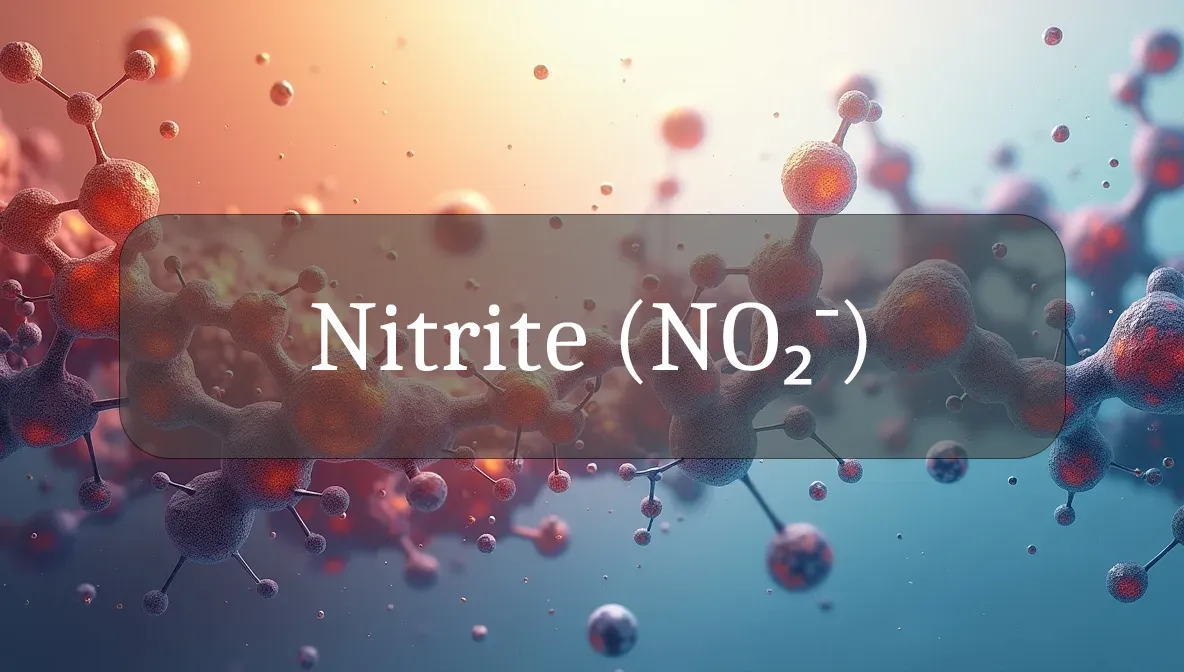Molecule That Supports Your Blood Flow and Heart Health
Nitrite (NO₂⁻) is like a tiny helper in your body, a molecule that supports healthy blood flow and protects your heart. It plays a key role in daily wellness by helping your blood vessels stay flexible and your cells energized. Let’s explore what nitrite is, how it benefits your health, and practical ways to support it—all in a clear, friendly way to empower your health choices.
Chemical Identity and Type
Nitrite (NO₂⁻) is an inorganic molecule and an anion (a negatively charged ion). It’s a key player in your body’s nitric oxide (NO) pathway, which regulates blood vessel function. Nitrite is formed in the body from dietary nitrates (NO₃⁻) found in foods or produced during metabolism. It acts as a body signal, helping convert to nitric oxide, which relaxes blood vessels and supports oxygen delivery.
Biological Role and Benefits
Nitrite is your body’s blood flow booster, supporting heart and cell health. Here’s how it helps your wellness:
- Blood Vessel Health: Nitrite converts to nitric oxide, relaxing blood vessels to improve blood flow and lower blood pressure.
- Heart Support: Better blood flow reduces strain on the heart, promoting cardiovascular health.
- Oxygen Delivery: Nitrite enhances oxygen use in cells, especially during exercise or low-oxygen conditions, boosting stamina.
- Antioxidant Protection: It acts as a cell protector, reducing damage from harmful molecules (free radicals).
- Energy Efficiency: By improving oxygen delivery, nitrite supports energy production in muscles and organs.
By enhancing circulation and oxygen use, nitrite boosts your energy, heart health, and overall vitality.
Dietary or Natural Sources
Your body produces nitrite from dietary nitrates or through internal processes. Top sources of nitrates include:
- Vegetables: Spinach, arugula, beets, celery, and lettuce (high in nitrates, which convert to nitrite).
- Fruits: Pomegranates and watermelon (contain nitrate precursors).
- Animal-Based: Cured meats (e.g., bacon, ham) contain nitrites as preservatives, but limit due to health concerns.
- Nutrient Boosters: Vitamin C (oranges, bell peppers) and polyphenols (berries, dark chocolate) enhance nitrate-to-nitrite conversion.
- Water: Some drinking water contains nitrates, depending on the source.
Supplements like beetroot powder or nitrate salts (500–1,000 mg daily) can boost nitrate intake. Aim for 6.4–12.8 mg of nitrate per kilogram of body weight daily (e.g., 400–800 mg for a 150-pound person), achievable through vegetable-rich diets.
Signs of Imbalance or Dysfunction
Nitrite imbalance, often due to poor diet or health conditions, can show up as:
- Low Nitrite/Nitrate Levels:
- Fatigue or low stamina (poor oxygen delivery).
- High blood pressure or poor circulation.
- Muscle weakness during exercise.
- High Nitrite Levels (Rare, Often From Excess Intake)**:
- Blue skin or lips (methemoglobinemia, reducing oxygen in blood).
- Dizziness or shortness of breath.
- Nausea or headache.
Low levels may stem from low vegetable intake or impaired nitric oxide production, while high levels are rare but linked to excessive cured meat consumption or contaminated water.
Supporting Optimal Levels or Function
To keep nitrite levels healthy and maintain its benefits, try these practical steps:
- Eat Nitrate-Rich Foods: Include leafy greens (spinach, arugula) or beets in meals to boost nitrate-to-nitrite conversion.
- Boost Supporting Nutrients: Eat vitamin C-rich foods (strawberries, peppers) and polyphenols (blueberries, cocoa) to enhance nitrite production.
- Stay Active: Moderate exercise like walking or cycling increases nitric oxide production, amplifying nitrite’s benefits.
- Hydrate Well: Drink 8–10 cups of water daily to support circulation and kidney function.
- Get Enough Sleep: Aim for 7–9 hours to promote heart health and nitric oxide pathways.
- Limit Processed Meats: Reduce cured meats (bacon, sausages) to avoid excess nitrites and health risks.
- Avoid Smoking: Tobacco impairs nitric oxide production, reducing nitrite’s effectiveness.
Safety, Interactions, and Precautions
Nitrite is safe when produced naturally or consumed through whole foods, but consider these points:
- Excess Nitrites: High intake from cured meats or contaminated water may increase methemoglobinemia risk or, in rare cases, cancer risk (due to nitrosamine formation).
- Medical Conditions: Heart or kidney disease may affect nitric oxide pathways, requiring medical guidance.
- Supplements: Beetroot or nitrate supplements are generally safe but may cause stomach upset or low blood pressure in high doses (above 2,000 mg daily).
- Medications: Nitrate supplements may interact with blood pressure drugs (e.g., Viagra, nitrates), causing unsafe drops in blood pressure. Consult your doctor.
- Water Quality: Avoid well water high in nitrates, especially for infants, to prevent health risks.
Prioritize whole food sources like vegetables over supplements or processed foods.
Fun Fact
Did you know your saliva helps make nitrite? Bacteria in your mouth convert dietary nitrates from veggies into nitrite, kicking off the process that keeps your blood vessels happy—your smile is literally good for your heart!
Citations
- National Institutes of Health. (2023). Nitric oxide and cardiovascular health. MedlinePlus.
- Mayo Clinic. (2024). Nutrition for heart and blood vessel health.
- Cleveland Clinic. (2022). The role of nitrates and nitrites in circulation.
- World Health Organization. (2020). Nitrate and nitrite in drinking water.
- USDA FoodData Central. (2023). Nutrient profiles for nitrate-rich foods.

